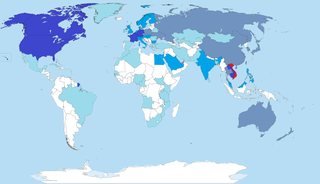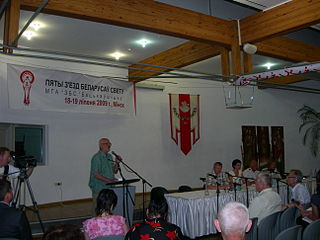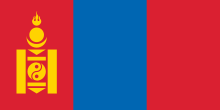
Mongolia is a landlocked country in East Asia, bordered by Russia to the north and China to the south. It covers an area of 1,564,116 square kilometres, with a population of just 3.3 million, making it the world's most sparsely populated sovereign state. Mongolia is the world's largest landlocked country that does not border a closed sea, and much of its area is covered by grassy steppe, with mountains to the north and west and the Gobi Desert to the south. Ulaanbaatar, the capital and largest city, is home to roughly half of the country's population.

The Japanese diaspora and its individual members, known as Nikkei (日系) or as Nikkeijin (日系人), comprise the Japanese emigrants from Japan residing in a country outside Japan. Emigration from Japan was recorded as early as the 15th century to the Philippines, but did not become a mass phenomenon until the Meiji period (1868–1912), when Japanese emigrated to the Philippines and to the Americas. There was significant emigration to the territories of the Empire of Japan during the period of Japanese colonial expansion (1875–1945); however, most of these emigrants repatriated to Japan after the 1945 surrender of Japan ended World War II in Asia.

Overseas Vietnamese refers to Vietnamese people who live outside Vietnam. There are approximately 5 million overseas Vietnamese, the largest community of whom live in the United States.
Latin Americans are the citizens of Latin American countries.

The Greek diaspora, also known as Omogenia, are the communities of Greeks living outside of Greece and Cyprus.

The Korean diaspora consists of around 7.3 million people, both descendants of early emigrants from the Korean Peninsula, as well as more recent emigrants from Korea. Around 84.5% of overseas Koreans live in just five countries: China, the United States, Japan, Canada, and Uzbekistan. Other countries with greater than 0.5% Korean minorities include Brazil, Russia, Kazakhstan, Vietnam, the Philippines, and Indonesia. All these figures include both permanent migrants and sojourners.
Asia is the largest and most populous continent and the birthplace of many religions including Buddhism, Christianity, Confucianism, Hinduism, Islam, Jainism, Judaism, Shinto, Sikhism, Taoism, and Zoroastrianism. All major religious traditions are practiced in the region and new forms are constantly emerging. Asia is noted for its diversity of culture. Islam is the largest religion in Asia with approximately 1.3 billion adherents.

The Russian diaspora is the global community of ethnic Russians. The Russian-speaking (Russophone) diaspora are the people for whom Russian language is the native language, regardless of whether they are ethnic Russians or not.

Czech Americans, known in the 19th and early 20th century as Bohemian Americans, are citizens of the United States whose ancestry is wholly or partly originate from the Czech lands, a term which refers to the majority of the traditional lands of the Bohemian Crown, namely Bohemia, Moravia and Czech Silesia. These lands over time have been governed by a variety of states, including the Kingdom of Bohemia, the Austrian Empire, Czechoslovakia, and the Czech Republic also known by its short-form name, Czechia. Germans from the Czech lands who emigrated to the United States are usually identified as German Americans, or, more specifically, as Americans of German Bohemian descent. According to the 2000 U.S. census, there are 1,262,527 Americans of full or partial Czech descent, in addition to 441,403 persons who list their ancestry as Czechoslovak. Historical information about Czechs in America is available thanks to people such as Mila Rechcigl.
East Asians in the United Kingdom are East Asians living in the United Kingdom. They have been present in the country since the 17th century and primarily originate from countries such as China, Hong Kong, Japan, South Korea and Taiwan. They are called "East Asian" or "Oriental", although – dependent upon the context – the use of the term "Oriental" might be considered by some to be derogatory or offensive. In the 2001 British census, the term Chinese or Other is used.

Overseas Pakistanis, or the Pakistani diaspora, refers to Pakistanis who live outside of Pakistan. These include citizens that have migrated to another country as well as people born abroad of Pakistani descent. According to the Ministry of Overseas Pakistanis and Human Resource Development, approximately 8.8 million Pakistanis live abroad according to December 2017 estimates. According to the Ministry of Emigration and Overseas Employment, data released in 2023 states that more than 10.80 million people have moved abroad since 1990.

Overseas Indonesians refers to Indonesians who live outside of Indonesia. These include citizens that have migrated to another country as well as people born abroad of Indonesian descent. According to Ministry of Law and Human Rights, more than 6 million Indonesians diaspora live abroad in 2023 this include ex-Indonesian citizens, foreign citizens who are children of Indonesian citizens, and children of ex-Indonesian citizens, illegal and undocumented workers.

The Bangladeshi diaspora are people of Bangladeshi birth, descent or origin who live outside of Bangladesh. First-generation migrants may have moved abroad from Bangladesh for various reasons including better living conditions, to escape poverty, to support their financial condition, or to send money back to families there. The Ministry of Expatriates' Welfare and Overseas Employment estimates there are almost 7.5 million Bangladeshis living abroad, the fourth highest among the top 176 countries of origin for international migrants. Annual remittances transferred to Bangladesh were almost $23 billion in 2023, the seventh highest in the world and the third highest in South Asia.

The Belarusian diaspora refers to emigrants from the territory of Belarus as well as to their descendants.

Emigration from the United States is the process where citizens from the United States move to live in countries other than the US, creating an American Diaspora. The process is the reverse of the immigration to the United States. The United States does not keep track of emigration and counts of Americans abroad are thus only available based on statistics kept by the destination countries.

Overseas Indians, officially Non-Resident Indians (NRIs) and People of Indian Origin (PIOs) are Indians who reside or originate outside of India. According to the Government of India, Non-Resident Indians are citizens of India who currently are not living in India, while the term People of Indian Origin refers to people of Indian birth or ancestry who are citizens of countries other than India. Overseas Citizenship of India (OCI) is given to People of Indian Origin and to persons who are not People of Indian Origin but married to Indian citizen or People of Indian Origin. Persons with OCI status are known as Overseas Citizens of India (OCIs). The OCI status is a permanent visa for visiting India with a foreign passport.

In South Korea, immigration policy is handled by the immigration services of the Ministry of Justice, Ministry of Labor, Ministry of Health and Welfare and the Ministry of Foreign Affairs and Trade. The Nationality Act, Immigration Control Act, Multicultural Families Support Act, and the Framework Act on Treatment of Foreigners are the foundations of immigration policy in Korea. The Korean government initiated a discussion in 2003 on establishing an independent immigration office to accommodate fast-growing immigrant and to prepare inclusive and rational immigration policies; however, there has been little progress. The Foreigner Policy Committee, headed by the Prime Minister, coordinates foreigner-related policies which were handled by many ministries. However, its role is limited because of a shortage of resources and manpower. The establishment of an Immigration Office is expected to solve these problems by concentrating all related resources and manpower under one umbrella.

Ukhnaagiin Khürelsükh, also referred to as Khürelsükh Ukhnaa, is the 6th and current president of Mongolia, beginning his term on 25 June 2021 after winning the 2021 Mongolian presidential election. He was prime minister from October 2017 to January 2021 and was elected to the Parliament of Mongolia four times – in 2000, 2004, 2012 and 2020.

East Asian Canadians are Canadians who were either born in or can trace their ancestry to East Asia. East Asian Canadians are also a subgroup of Asian Canadians. According to Statistics Canada, East Asian Canadians are considered visible minorities and can be further divided by on the basis of both ethnicity and nationality, such as Chinese Canadian, Hong Kong Canadian, Japanese Canadian, Korean Canadian, Mongolian Canadian, Taiwanese Canadian, or Tibetan Canadian, as seen on demi-decadal census data.
















